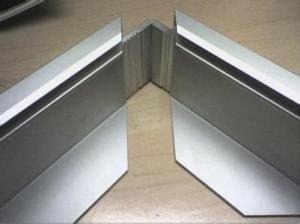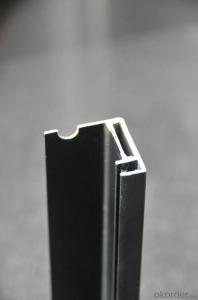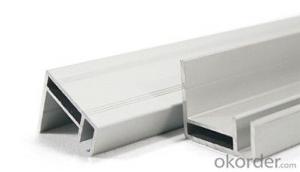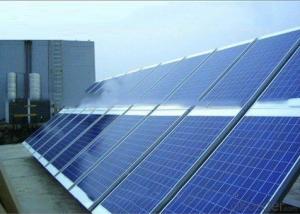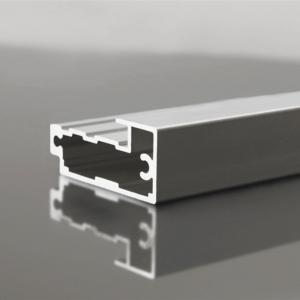Aluminum Solar Module Frame AA6061 with T Slot Miter T Track Aluminum Profiles
- Loading Port:
- China Main Port
- Payment Terms:
- TT OR LC
- Min Order Qty:
- -
- Supply Capability:
- -
OKorder Service Pledge
OKorder Financial Service
You Might Also Like
Material:
Aluminum alloy6061/6063 T3-T8 or follow customer’s demand.( Aluminium profile for PV solar panel frame)
Surface treatment:
1.Anodizing: silver/black mainly and other multicolor.
2.Electrophoresis
3.Powder coating/ PVDF polishing/ sand blasting etc.
Two types:
1) 90-angle
2) 45-angle
Specifications:
1)30*25mm suitable for 30-120W solar modules.
2)35*35mm suitable for 160-220W solar modules.
3)40*35/45*35/50*35 suitable for 200w above.
The size are available in accordance with customers' requirement.
- Q: Are there any materials for aluminum profiles?
- Yes, aluminum, silicon, aluminum, magnesium and so on
- Q: This question asks about the various dimensions and forms of aluminum profiles that are typically utilized in the construction of building frames.
- <p>Aluminum profiles used in building frames come in a variety of sizes and shapes to meet different structural requirements. Common profiles include rectangular tubes, square tubes, angles (L-profiles), channels, and tees. Sizes range from small (e.g., 10x10mm to 30x30mm) to large (e.g., 100x100mm to 200x200mm), with thicknesses varying from 1mm to 6mm or more. Shapes are tailored to specific applications; for example, I-beams and H-beams are used for their high strength-to-weight ratio. These profiles are chosen based on load-bearing needs, aesthetic preferences, and construction techniques.</p>
- Q: Are aluminum profiles suitable for sports equipment?
- Sports equipment can be made using aluminum profiles, as they are lightweight and durable. Aluminum has a high strength-to-weight ratio, making it perfect for applications that require strength without excessive weight. Various sports equipment, including bicycles, golf clubs, baseball bats, tennis rackets, and even sports stadiums and arenas, commonly use aluminum profiles. The lightweight nature of aluminum allows athletes to handle the equipment easily, leading to better performance and less fatigue during sports activities. Moreover, aluminum's durability ensures that the equipment can endure intense use and last longer. The versatility of aluminum profiles also makes them suitable for sports equipment. They can be easily shaped, molded, and manipulated into different designs to meet specific performance requirements. This flexibility enables manufacturers to create equipment with desired characteristics, such as improved aerodynamics, better balance, or enhanced shock absorption. Furthermore, aluminum profiles have excellent corrosion resistance, which is especially crucial for sports equipment that may be exposed to moisture, sweat, or harsh environmental conditions. This property guarantees that the equipment remains functional and maintains its performance over time. In conclusion, aluminum profiles are a suitable choice for sports equipment because of their lightweight, durable, and versatile nature. With their high strength-to-weight ratio, they contribute to improved performance, reduced fatigue, and extended equipment lifespan.
- Q: What are the different tolerance levels for aluminum profiles?
- The specific requirements and applications can cause the tolerance levels for aluminum profiles to differ. Various industries, including automotive, aerospace, and construction, typically demand aluminum profiles with tight tolerance levels. Aluminum profiles commonly have dimensional tolerances, straightness tolerances, and surface finish tolerances. The dimensional tolerances ensure that the profile meets the required measurements and fits properly in its intended application. Typically, these tolerances are specified in millimeters or inches. Straightness tolerances guarantee that the aluminum profile does not deviate from a perfectly straight line. This is vital for maintaining structural integrity and accurate assembly. Surface finish tolerances determine the acceptable level of imperfections on the profile's surface, such as scratches, indentations, or roughness. These tolerances are often specified in terms of roughness average (Ra) or surface quality codes, like anodized or powder-coated finishes. It is crucial to consider that the tolerance levels for aluminum profiles can vary depending on factors such as the manufacturing process, intended application, and industry standards. Therefore, it is essential to consult relevant specifications, industry standards, or the supplier's guidelines to determine the precise tolerance levels for a specific aluminum profile.
- Q: Can aluminum profiles be used in display stand and podium manufacturing?
- Yes, aluminum profiles can definitely be used in display stand and podium manufacturing. Aluminum is a highly versatile and durable material that offers several advantages such as lightweight, corrosion resistance, and easy customization. It can be easily shaped and fabricated into various designs and sizes, making it suitable for creating aesthetically appealing and functional display stands and podiums. Additionally, aluminum profiles can also be an excellent choice for portable or temporary setups due to their portability and easy assembly.
- Q: What does "3030W" W mean for European standard industrial aluminum?
- This refers to the 3030 heavy aluminum profiles. General aluminum profile manufacturers will make a number of their own products, European standard 3030 series has a variety of specifications, such as Jing Teng aluminum European standard 3030R, referring to the European standard 3030 fan, 3030G refers to the 3030 GB profiles. In short, look at your own needs,
- Q: What specific criteria or standards must be met when employing aluminum profiles in commercial construction?
- <p>Yes, there are special requirements for using aluminum profiles in commercial buildings. These include adherence to building codes and regulations, which vary by region. Profiles must meet specific strength and durability standards to ensure structural integrity. They should also comply with fire safety and energy efficiency requirements. Additionally, the profiles need to be resistant to corrosion and weathering, and must be compatible with other building materials. Aesthetic considerations, such as color and finish, are also important to match the building's design. It's crucial to work with certified suppliers and follow proper installation procedures to meet these requirements.</p>
- Q: Can aluminum profiles be used for access platforms?
- Yes, aluminum profiles can be used for access platforms. Aluminum is a lightweight and durable material that is commonly used in various industrial applications, including access platforms. It offers high strength-to-weight ratio, corrosion resistance, and easy fabrication, making it an ideal choice for constructing access platforms that need to be strong, stable, and long-lasting.
- Q: This question asks about the various types of aluminum profiles that are utilized for the purpose of exterior wall cladding.
- <p>Aluminum profiles for exterior wall cladding come in various types, each serving specific design and structural needs. Common types include: 1. Flat Profiles, which are simple and versatile for basic cladding. 2. Box Profiles, offering a sleek, modern look and are often used for commercial buildings. 3. L-Profiles, used for corner sections and providing structural support. 4. U-Channels, which are used for concealing fasteners and creating a clean appearance. 5. Angle Profiles, used for creating corners and edges. 6. Special Profiles, designed for specific architectural features. Each type is chosen based on the aesthetic, structural integrity, and weather resistance required for the project.</p>
- Q: This question asks for guidance on ensuring a safe and efficient installation process for aluminum profiles.
- <p>To ensure a safe and efficient installation process for aluminum profiles, follow these steps: Use appropriate safety gear such as gloves and goggles. Ensure the profiles are of high quality and fit for purpose. Plan the installation carefully, marking out the positions accurately. Use the correct tools for cutting and drilling, and ensure they are sharp and well-maintained. Install the profiles in a clean, dry environment to prevent damage. Follow the manufacturer's guidelines for assembly and use the correct fasteners. Regularly inspect the installation for any signs of wear or damage. By adhering to these practices, you can ensure a safe and efficient installation process.</p>
Send your message to us
Aluminum Solar Module Frame AA6061 with T Slot Miter T Track Aluminum Profiles
- Loading Port:
- China Main Port
- Payment Terms:
- TT OR LC
- Min Order Qty:
- -
- Supply Capability:
- -
OKorder Service Pledge
OKorder Financial Service
Similar products
Hot products
Hot Searches
Related keywords
